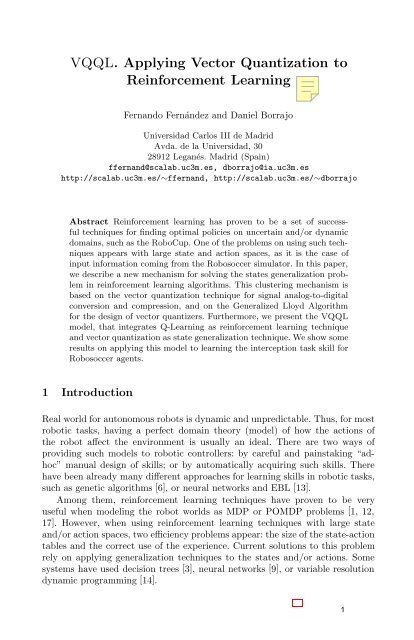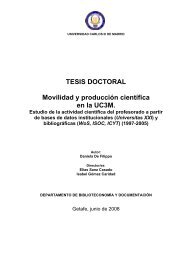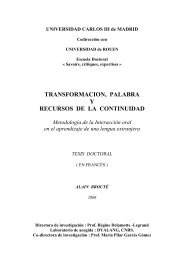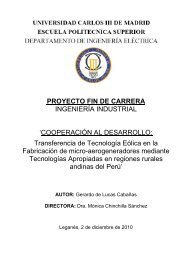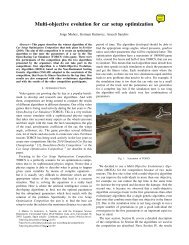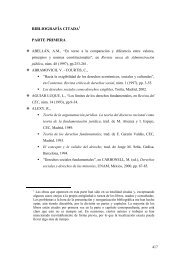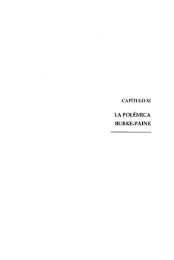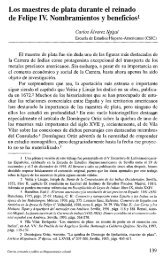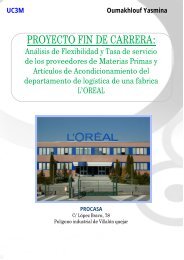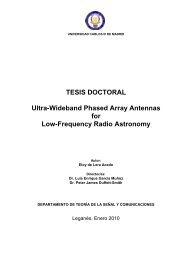VQQL. Applying Vector Quantization to Reinforcement Learning
VQQL. Applying Vector Quantization to Reinforcement Learning
VQQL. Applying Vector Quantization to Reinforcement Learning
You also want an ePaper? Increase the reach of your titles
YUMPU automatically turns print PDFs into web optimized ePapers that Google loves.
<strong>VQQL</strong>. <strong>Applying</strong> <strong>Vec<strong>to</strong>r</strong> <strong>Quantization</strong> <strong>to</strong><br />
<strong>Reinforcement</strong> <strong>Learning</strong><br />
Fernando Fernández and Daniel Borrajo<br />
Universidad Carlos III de Madrid<br />
Avda. de la Universidad, 30<br />
28912 Leganés. Madrid (Spain)<br />
ffernand@scalab.uc3m.es, dborrajo@ia.uc3m.es<br />
http://scalab.uc3m.es/∼ffernand, http://scalab.uc3m.es/∼dborrajo<br />
Abstract <strong>Reinforcement</strong> learning has proven <strong>to</strong> be a set of successful<br />
techniques for finding optimal policies on uncertain and/or dynamic<br />
domains, such as the RoboCup. One of the problems on using such techniques<br />
appears with large state and action spaces, as it is the case of<br />
input information coming from the Robosoccer simula<strong>to</strong>r. In this paper,<br />
we describe a new mechanism for solving the states generalization problem<br />
in reinforcement learning algorithms. This clustering mechanism is<br />
based on the vec<strong>to</strong>r quantization technique for signal analog-<strong>to</strong>-digital<br />
conversion and compression, and on the Generalized Lloyd Algorithm<br />
for the design of vec<strong>to</strong>r quantizers. Furthermore, we present the <strong>VQQL</strong><br />
model, that integrates Q-<strong>Learning</strong> as reinforcement learning technique<br />
and vec<strong>to</strong>r quantization as state generalization technique. We show some<br />
results on applying this model <strong>to</strong> learning the interception task skill for<br />
Robosoccer agents.<br />
1 Introduction<br />
Real world for au<strong>to</strong>nomous robots is dynamic and unpredictable. Thus, for most<br />
robotic tasks, having a perfect domain theory (model) of how the actions of<br />
the robot affect the environment is usually an ideal. There are two ways of<br />
providing such models <strong>to</strong> robotic controllers: by careful and painstaking “adhoc”<br />
manual design of skills; or by au<strong>to</strong>matically acquiring such skills. There<br />
have been already many different approaches for learning skills in robotic tasks,<br />
such as genetic algorithms [6], or neural networks and EBL [13].<br />
Among them, reinforcement learning techniques have proven <strong>to</strong> be very<br />
useful when modeling the robot worlds as MDP or POMDP problems [1, 12,<br />
17]. However, when using reinforcement learning techniques with large state<br />
and/or action spaces, two efficiency problems appear: the size of the state-action<br />
tables and the correct use of the experience. Current solutions <strong>to</strong> this problem<br />
rely on applying generalization techniques <strong>to</strong> the states and/or actions. Some<br />
systems have used decision trees [3], neural networks [9], or variable resolution<br />
dynamic programming [14].<br />
1
In this paper, we present an approach <strong>to</strong> solve the generalization problem<br />
that uses a numerical clustering method: the generalized Lloyd algorithm for<br />
the design of vec<strong>to</strong>r quantizers [10]. This technique is extensively employed for<br />
signal analog-<strong>to</strong>-digital conversion and compression, which have common characteristics<br />
<strong>to</strong> MDP problems. We have used Q-<strong>Learning</strong> [18] as reinforcement<br />
learning algorithm, integrating it with vec<strong>to</strong>r quantization techniques in the<br />
<strong>VQQL</strong> model.<br />
We have applied this model for compacting the set of states that a Robosoccer<br />
agent perceives, thus dramatically reducing the reinforcement table size. In<br />
particular, we have used the combination of vec<strong>to</strong>r quantization and reinforcement<br />
learning for acquiring the ball interception skill for agents playing in the<br />
Robosoccer simula<strong>to</strong>r [16].<br />
We introduce the reinforcement learning and the Q-learning algorithm in<br />
section 2. Then, the vec<strong>to</strong>r quantization technique and the generalized Lloyd<br />
algorithm are described in section 3. Section 4 describes how vec<strong>to</strong>r quantization<br />
is used <strong>to</strong> solve the generalization problem in the model <strong>VQQL</strong>, and in sections 5<br />
and 6, the experiments performed <strong>to</strong> verify the utility of the model and the results<br />
are shown. Finally, the related work and conclusions are discussed.<br />
2 <strong>Reinforcement</strong> <strong>Learning</strong><br />
The main objective of reinforcement learning is <strong>to</strong> au<strong>to</strong>matically acquire knowledge<br />
<strong>to</strong> better decide what action an agent should perform at any moment <strong>to</strong><br />
optimally achieve a goal. Among many different reinforcement learning techniques,<br />
Q-learning has been very widely used [18]. The Q-learning algorithm for<br />
non deterministic Markov decision processes is described in table 1 (execution<br />
of the same action from the same state by an agent arrives <strong>to</strong> different states, so<br />
different rewards could be obtained). It needs a definition of the possible states,<br />
S, the actions that the agent can perform in the environment, A, and the rewards<br />
that it receives at any moment for the states it arrives <strong>to</strong> after applying each<br />
action, r. It dynamically generates a reinforcement table Q(s, a) (using equation<br />
1) that allows it <strong>to</strong> follow a potentially optimal policy. Parameter γ controls<br />
the relative importance of future actions rewards with respect <strong>to</strong> immediate rewards.<br />
Parameter α refers <strong>to</strong> the probabilities involved, and it is computed using<br />
equation 2.<br />
Qn(s, a) ← (1 − αn)Qn−1(s, a)+αn{r + γ max<br />
a ′ Qn−1(s ′ ,a ′ )} (1)<br />
αn ←<br />
1<br />
1 + visitsn(s, a)<br />
where visitsn(s, a) is the <strong>to</strong>tal number of times that the state-action entry<br />
has been visited.<br />
2<br />
(2)
Q-learning algorithm (S, A)<br />
For each pair (s ∈S, a ∈A), initialize the table entry Q(s, a) <strong>to</strong>0.<br />
Observe the current state s<br />
Do forever<br />
– Select an action a and execute it<br />
– Receive immediate reward r<br />
– Observe the new state s ′<br />
– Update the table entry for Q(s, a) using equation 1<br />
– Set s <strong>to</strong> s ′<br />
Table1. Q-learning algorithm.<br />
3 <strong>Vec<strong>to</strong>r</strong> <strong>Quantization</strong> (VQ)<br />
<strong>Vec<strong>to</strong>r</strong> quantization appeared as an appropriate way of reducing the number of<br />
bits needed <strong>to</strong> represent and transmit information [7]. In the case of large state<br />
spaces in reinforcement learning, the problem is analogous: how can we compactly<br />
represent a huge number of states with very few information? In order <strong>to</strong> apply<br />
vec<strong>to</strong>r quantization <strong>to</strong> the reinforcement learning problem, we will provide first<br />
some definitions.<br />
3.1 Definitions<br />
Since our goal is <strong>to</strong> reduce the size of the reinforcement table, we have <strong>to</strong> find out<br />
a more compact representation of the states. 1 If we have K attributes describing<br />
the states, and each attribute ai can have values(ai) different values, where this<br />
number is usually big (in most cases infinite, since they are represented with real<br />
numbers), then the number of potential states can be computed as:<br />
S =<br />
K<br />
values(ai) (3)<br />
i=1<br />
Since this can be a huge number, the goal is <strong>to</strong> reduce it <strong>to</strong> N ≪ S new states.<br />
These N states have <strong>to</strong> be able <strong>to</strong> approximately capture the same information<br />
as the S states; that is, all similar states in the previous representation, belong<br />
<strong>to</strong> the same new state in the new representation. The first definition takes this<br />
in<strong>to</strong> account.<br />
Definition 1. A vec<strong>to</strong>r quantizer Q of dimension K and size N is a mapping<br />
from a vec<strong>to</strong>r (or a “point”) in the K-dimensional Euclidean space, R K , in<strong>to</strong><br />
a finite set C containing N output or reproduction points, called code vec<strong>to</strong>rs,<br />
codewords, orcodebook. Thus,<br />
Q : R K −→ C<br />
where C =(y1,y2,...,yN), yi ∈ R K .<br />
1 We will refer indistinctly <strong>to</strong> vec<strong>to</strong>rs and states.<br />
3
Given C (computed by the generalized Lloyd algorithm, explained below),<br />
and a vec<strong>to</strong>r x ∈ R K , Q(x) assigns x <strong>to</strong> the closest state from C. In order <strong>to</strong><br />
define the closeness of one vec<strong>to</strong>r x <strong>to</strong> a state in C, we need <strong>to</strong> define a measure of<br />
the quantization error, which needs a dis<strong>to</strong>rtion measure (analog <strong>to</strong> the similarity<br />
metric of clustering techniques).<br />
Definition 2. A dis<strong>to</strong>rtion measure d is an assignment of a nonnegative cost<br />
d(x, q) associated with quantizing any input vec<strong>to</strong>r x ∈ R K with a reproduction<br />
vec<strong>to</strong>r q = Q(x) ∈ C.<br />
In digital communications, the most convenient and widely used measure<br />
of dis<strong>to</strong>rtion between an input vec<strong>to</strong>r x and a quantizer vec<strong>to</strong>r q = Q(x), is<br />
the squared error or squared Euclidean distance between two vec<strong>to</strong>rs defined by<br />
equation 4.<br />
d(x, q) =x, q 2 =<br />
K<br />
(x[i] − q[i]) 2<br />
However, sometimes differences in one attribute value are more important<br />
than in another. In those cases, the weighted squared error measure is more<br />
useful, because it allows a different emphasis <strong>to</strong> be given <strong>to</strong> different vec<strong>to</strong>r components,<br />
as in equation 5. In other cases, the values x[i] and q[i] are normalized<br />
by the range of values of the attribute. This is a special case of the equation 5<br />
where weights would be computed as the inverse of the square of the range<br />
(maximum possible value minus minimum possible value).<br />
d(x, q) =<br />
i=1<br />
K<br />
wi(x[i] − q[i]) 2<br />
i=1<br />
Once a dis<strong>to</strong>rtion measure has been defined, we can define Q as in equation 6.<br />
(4)<br />
(5)<br />
Q(x) = arg min{d(x,<br />
y)} (6)<br />
y∈C<br />
In order <strong>to</strong> measure the average error produced by quantizing M training<br />
vec<strong>to</strong>rs xj with Q, average dis<strong>to</strong>rtion is defined as the expected dis<strong>to</strong>rtion calculated<br />
among any input vec<strong>to</strong>r and the quantizer Q:<br />
D = 1<br />
M<br />
M<br />
min<br />
y∈C d(xj,y) (7)<br />
j=1<br />
Finally, we define partition and centroid, concepts needed for presenting the<br />
Lloyd algorithm for computing C from M input vec<strong>to</strong>rs.<br />
Definition 3. A partition or cell Ri ⊆ R K is the set of input vec<strong>to</strong>rs (old states)<br />
associated <strong>to</strong> the same (new) state in the codebook C.<br />
4
Definition 4. We define the centroid, cent(R), of any set R ⊆ R K as that<br />
vec<strong>to</strong>r y ∈ R K that minimizes the dis<strong>to</strong>rtion between any point x in R and y:<br />
cent(R) = {y ∈ R K | E[d(x, y)] ≤ E[d(x, y ′ )], ∀x ∈ R, y ′ ∈ R K } (8)<br />
where E[z] is the expected value of z.<br />
A common formula <strong>to</strong> calculate each component i of the centroid of a partition<br />
is given by equation 9.<br />
cent(R)[i] = 1<br />
R <br />
xj[i] (9)<br />
R<br />
where xj ∈ R, xj[i] is the value of component (attribute) i of vec<strong>to</strong>r xj, and<br />
R is the cardinality of R.<br />
j=1<br />
3.2 Generalized Lloyd Algorithm (GLA)<br />
The generalized Lloyd algorithm is a clustering technique, extension of the scalar<br />
case [11]. It consists of a number of iterations, each one recomputing the set of<br />
more appropriate partitions of the input states (vec<strong>to</strong>rs), and their centroids.<br />
The algorithm is shown in table 2. It takes as input a set T of M input states,<br />
and generates as output the set C of N new states (quantization levels).<br />
Generalized Lloyd algorithm (T,N)<br />
1. Begin with an initial codebook C1.<br />
2. Repeat<br />
(a) Given a codebook (set of clusters defined by their centroids) Cm =<br />
{yi; i =1,...,N}, redistribute each vec<strong>to</strong>r (state) x ∈ T in<strong>to</strong> one of<br />
the clusters in Cm by selecting the one whose centroid is closer <strong>to</strong> x.<br />
(b) Recompute the centroids for each cluster just created, using the centroid<br />
definition in equation 9 <strong>to</strong> obtain the new codebook Cm+1.<br />
(c) If an empty cell (cluster) was generated in the previous step, an alternative<br />
code vec<strong>to</strong>r assignment is made (instead of the centroid computation).<br />
(d) Compute the average dis<strong>to</strong>rtion for Cm+1, Dm+1<br />
Until the dis<strong>to</strong>rtion has only changed by a small enough amount since last<br />
iteration.<br />
Table2. The generalized Lloyd algorithm.<br />
There are three design decisions <strong>to</strong> be made when using such technique:<br />
S<strong>to</strong>pping criterion Usually, average dis<strong>to</strong>rtion of codebook at cycle m, Dm,<br />
is computed and compared <strong>to</strong> a threshold θ (0 ≤ θ ≤ 1) as in equation 10.<br />
5
(Dm − Dm+1)/Dm
Off-line mode. We could obtain the information required <strong>to</strong> learn the quantizer<br />
and the Q function, and, later, learn both.<br />
On-line mode. We could obtain data <strong>to</strong> generate only the vec<strong>to</strong>r quantizer,<br />
and, later, the Q function is learned by the interaction of the agent with the<br />
environment, using the previously designed quantizer.<br />
The advantages of the first one are that it allows <strong>to</strong> use the same information<br />
several times, and the quantizer and the Q table are learned with the same data.<br />
The second one allows the agent <strong>to</strong> use greedy strategies in order <strong>to</strong> increase the<br />
learning rate (exploration versus exploitation).<br />
In both cases, the behavior of the agent, once the quantizer and the Q function<br />
are learned, is the same; a loop that:<br />
– Receives the current state, s, from the environment.<br />
– Obtains the quantization level, s ′ , or state <strong>to</strong> which the current state belongs.<br />
– Obtains the action, a, from the Q table with bigger Q value for s ′ .<br />
– Executes action a.<br />
5 The Robosoccer domain<br />
In order <strong>to</strong> verify the usefulness of the vec<strong>to</strong>r quantization technique <strong>to</strong> solve the<br />
generalization problem in reinforcement learning algorithms, we have selected a<br />
robotic soccer domain that presents us all the problems that we have defined in<br />
previous sections. The RoboCup, and its Soccer Server Simula<strong>to</strong>r, gives us the<br />
needed support [16].<br />
The Soccer Server provides an environment <strong>to</strong> confront two teams of players<br />
(agents). Each agent perceives at any moment two types of information: visual<br />
and audi<strong>to</strong>rial [16]. Visual information describes a player what it sees in the field.<br />
For example, an agent sees other agents, field marks such as the center of the<br />
field or the goals, and the ball. Audi<strong>to</strong>rial information describes a player what it<br />
hears in the field. A player can hear messages from the referee, from its coach, or<br />
from other players. Any agent (player) can execute actions such as run (dash),<br />
turn (turn), send messages (say), kick the ball (kick), catch the ball (catch), etc.<br />
One of the more basic skills a soccer player must have is ball interception. The<br />
importance of this skill comes from the dependency that other basic skills, such<br />
as kick or catch the ball, have with this one. Furthermore, ball interception is<br />
presented as one of the more difficult tasks <strong>to</strong> solve in the Robosoccer simula<strong>to</strong>r,<br />
and it has been studied in depth by other authors [17]. In the case of S<strong>to</strong>ne’s<br />
work, neural networks were used <strong>to</strong> solve the ball interception problem posed as<br />
a supervised learning task.<br />
The essential difficulties of this skill come from the visual limitations of the<br />
agent, as well as from the noise that the simula<strong>to</strong>r includes in movements of<br />
objects. In order <strong>to</strong> intercept the ball, our agents parse the visual information<br />
that they receive from the simula<strong>to</strong>r, and obtain the following information: 2<br />
2 The Robosoccer simula<strong>to</strong>r pro<strong>to</strong>col version 4.21 has been used for training. In other<br />
versions of the simula<strong>to</strong>r, other information could be obtained.<br />
7
– Relative Distance from the ball <strong>to</strong> the player.<br />
– Relative Direction from the ball <strong>to</strong> the player.<br />
– Distance Change, gives an idea of how Distance is changing.<br />
– Direction Change, gives an idea of how Direction is changing.<br />
In order <strong>to</strong> intercept the ball, after knowing the values of these parameters,<br />
each player can execute several actions:<br />
Turn changing the direction of the player according <strong>to</strong> a moment between -180<br />
and 180 degrees.<br />
Dash increasing the velocity of the player in the direction it is facing with a<br />
power between -30 and 100.<br />
To reduce the number of possible actions that an agent can perform (generalization<br />
over actions problem), we have used macro-actions defined as follows.<br />
Macro-actions are composed of two consecutive actions: turn(T ), and dash(D),<br />
resulting in turn-dash(T,D). We have selected D = 100, and T is computed<br />
according <strong>to</strong> A + ∆A, where A is the angle between the agent and the ball, and<br />
∆A can be: +45,+10,0,-10,-45. Therefore, we have reduced the set of actions <strong>to</strong><br />
five actions.<br />
6 Results<br />
In this section, the results of using the <strong>VQQL</strong> model for learning the ball interception<br />
skill in the Robosoccer domain are shown. In order <strong>to</strong> test the performance<br />
of the Lloyd algorithm, we generated a training set of 94.852 states with<br />
the following iterative process, similar <strong>to</strong> the one used in [17]:<br />
– The goalie starts at a distance of four meters in front of the center of the<br />
goal, facing directly away from the goal.<br />
– The ball and the shooter are placed randomly at a distance between 15 and<br />
25 from the defender.<br />
– For each training example, the shooter kicks the ball <strong>to</strong>wards the center of<br />
the goal with a maximum power (100), and an angle in the range (−20, 20).<br />
– The defender goal is <strong>to</strong> catch the ball. It waits until the ball is at a distance<br />
less or equal than 14, and starts <strong>to</strong> execute actions defined in section 5,<br />
while the goal is not in the catchable area [16]. Currently, we are only giving<br />
positive rewards. Therefore, if the ball is in the catchable area, the goalie<br />
tries <strong>to</strong> catch the ball, and if it succeeds, a positive reward is given <strong>to</strong> the<br />
last decision. If the goalie does not catch the ball, it can execute new actions.<br />
Finally, if the shooter goals, or the ball goes out of the field, it receives a<br />
reward of 0.<br />
Then, we used the algorithm described in Section 3 with different number<br />
of quantization levels (new states). Figure 1 shows the evolution of the average<br />
dis<strong>to</strong>rtion of the training sequence. The x-axis shows the logarithm of the<br />
8
number of quantization levels, i.e. the number of different states what will be<br />
used afterwards by the reinforcement learning algorithm and the y-axis shows<br />
the average dis<strong>to</strong>rtion obtained by GLA. The dis<strong>to</strong>rtion measure used has been<br />
the quadratic error, as shown in equation 4. As it can be seen, when using 2 6 <strong>to</strong><br />
2 8 quantization levels, the dis<strong>to</strong>rtion becomes practically 0.<br />
Dis<strong>to</strong>rtion<br />
1200<br />
1000<br />
800<br />
600<br />
400<br />
200<br />
Dis<strong>to</strong>rtion Evolution<br />
0<br />
0 2 4 6 8<br />
log2 N<br />
10 12 14<br />
Figure1. Average dis<strong>to</strong>rtion evolution depending on the number of states in the codebook.<br />
To solve the state generalization problem, a single mechanism could be used,<br />
such as a typical scalar quantization on each parameter. In this case, the average<br />
quantization error, following the error quadratic dis<strong>to</strong>rtion measure defined in<br />
equation 4, could be calculated as follows. The Distance parameter range is<br />
usually in (0.9,17.3). Thus, if we allow 0.5 as the maximum quantization error,<br />
we need around 17 levels. Direction is in the (-179,179) range, so, if we allow a<br />
quantization error of 2, 90 levels will be needed. Distance Change parameter is<br />
usually in (-1.9,1), so we need close <strong>to</strong> 15 levels, allowing an error of 0.1, and<br />
Direction Change is usually in (-170,170), so we need 85 levels, allowing an error<br />
of 2. Then, following equation 3 we need 17∗90∗15∗85 = 1, 950, 750 states!!! This<br />
is a huge size for a reinforcement learning approach. Also, the average dis<strong>to</strong>rtion<br />
that is obtained according <strong>to</strong> equation 4 is:<br />
( 0.5<br />
2 )2 +( 2<br />
2 )2 +( 0.1<br />
2 )2 +( 2<br />
2 )2 =2.7<br />
given that the quantization error on each quantization is half of the maximum<br />
possible error. Instead, using the generalized Lloyd algorithm, with many less<br />
states, 2048, the average dis<strong>to</strong>rtion goes under 2.0. So, it reduces both the number<br />
of states <strong>to</strong> be represented, and the average quantization error.<br />
Why is this reduction possible on the quantization error? The answer is given<br />
by the statistical advantages that the vec<strong>to</strong>r quantization provides over the scalar<br />
quantization. These advantages can be seen in Figure 2. In Figure 2(a), only<br />
the pairs of Distance and Direction that appeared in the training vec<strong>to</strong>rs have<br />
been plotted. As we can see, only some regions of the bidimensional space have<br />
values, showing that not all combinations of the possible values of the Distance<br />
and Direction parameters exist in the training set of input states. Therefore, the<br />
9
einforcement tables do not have <strong>to</strong> consider all possible combinations of these<br />
two parameters. Precisely, this is what vec<strong>to</strong>r quantization does. Figure 2(b)<br />
shows the points considered by 1024 states quantization. As it can be seen, it<br />
only generates states that represent minimally the states in the training set. The<br />
fact that there are parts of the space that are not covered by the quantization<br />
is due <strong>to</strong> the importance of the other two fac<strong>to</strong>rs not considered in the figure<br />
(change in distance and direction).<br />
Direction<br />
Parameters (Distance Direction)<br />
200<br />
150<br />
100<br />
50<br />
0<br />
-50<br />
-100<br />
-150<br />
-200<br />
0 2 4 6 8 10 12 14 16 18 20<br />
Distance<br />
(a) (b)<br />
Direction<br />
Parametres (Distance Direction)<br />
200<br />
150<br />
100<br />
50<br />
0<br />
-50<br />
-100<br />
-150<br />
-200<br />
0 2 4 6 8 10 12 14 16 18<br />
Distance<br />
Figure2. Distance and Direction parameters from (a) original data, and (b) a codebook<br />
obtained by the GLA.<br />
In order <strong>to</strong> test what the best number of quantization levels is, we have<br />
varied that number, and learned a Q table per obtained quantizer. We measured<br />
successful performance as the percentage of kicks of a new set of 100 testing<br />
problems that go <strong>to</strong>wards the goal, and are catched by the goalie. The results<br />
of these experiments are shown in Figure 3. In that figure the performance of<br />
the goalie is shown, depending of the size of the Q table. As a reference, a<br />
random goalie would only achieve a 20% of success, and a goalie with the most<br />
used heuristic of always go <strong>to</strong>wards the ball achieves only a 25% of successful<br />
behavior. As it can be seen, Q table sizes less than 128 obtain a quasi-random<br />
behavior. From sizes of the Q table from 128 <strong>to</strong> 1024, the performance increases<br />
until the maximum performance obtained, which is close <strong>to</strong> 60%. From 4096<br />
states and up, the performance decreases. That might be the effect of obtaining<br />
again a very large domain (huge number of state).<br />
7 Related Work<br />
Other models <strong>to</strong> solve the generalization problem in reinforcement learning use<br />
decision trees as in the G-learning algorithm [3], and kd-trees (similar <strong>to</strong> a decision<br />
tree) in the VRDP algorithm [14]. Another solution is Moore’s PartiGame<br />
algorithm [15] or neural networks [9]. One advantage of vec<strong>to</strong>r quantization is<br />
that it allows <strong>to</strong> easily define control parameters for obtaining different behaviors<br />
of the reinforcement learning technique. The main two parameters that have <strong>to</strong><br />
be defined are number of quantization levels, and average dis<strong>to</strong>rtion (similarity<br />
10
goals(%)<br />
0.65<br />
0.6<br />
0.55<br />
0.5<br />
0.45<br />
0.4<br />
0.35<br />
0.3<br />
<strong>Learning</strong> Performance<br />
0.25<br />
4 5 6 7 8 9 10 11 12 13<br />
log2 N<br />
Figure3. <strong>Learning</strong> performance depending on the number of states in the codebook.<br />
metric). Other approaches <strong>to</strong> this problem were proposed in [5] and [2] where<br />
bayesian networks are used. Similar ideas <strong>to</strong> our approach <strong>to</strong> <strong>Vec<strong>to</strong>r</strong> <strong>Quantization</strong><br />
have been used by other researchers, as in [4] where Q-<strong>Learning</strong> is used as<br />
in this paper, using LVQ [8]. Again, it is easier for VQ <strong>to</strong> define its learning<br />
parameters than it is for neural networks based systems.<br />
8 Conclusions and Future Work<br />
In this paper, we have shown that the use of vec<strong>to</strong>r quantization for the generalization<br />
problem of reinforcement learning techniques provides a solution <strong>to</strong><br />
how <strong>to</strong> partition a continuous environment in<strong>to</strong> regions of states that can be<br />
considered the same for the purposes of learning and generating actions. It also<br />
solves the problem of knowing what granularity or placement of partitions is<br />
more appropriate.<br />
However, this mechanism introduces a set of open questions that we expect<br />
<strong>to</strong> tackle next. As we explained above, the GL algorithm allows us <strong>to</strong> generate<br />
codebooks or sets of states of different sizes, each of them giving us different<br />
quantization errors. So, an important question is the relation between the number<br />
of quantization levels and the performance of the reinforcement learning<br />
algorithm. Another important issue relates <strong>to</strong> whether this technique can be<br />
applied not only <strong>to</strong> the state generalization problem, but also <strong>to</strong> actions generalization.<br />
We are also currently exploring the influence of providing negative<br />
rewards <strong>to</strong> the reinforcement learning technique. Finally, in the short term we<br />
intend <strong>to</strong> compare it against using decision trees and LVQ.<br />
References<br />
1. Jacky Baltes and Yuming Lin. Path-tracking control of non-holonomic car-like<br />
robot with reinforcement learning. In Manuela Veloso, edi<strong>to</strong>r, Working notes of<br />
the IJCAI’99 Third International Workshop on Robocup, pages 17–21, S<strong>to</strong>ckholm,<br />
Sweden, July-August 1999. IJCAI Press.<br />
11
2. Craig Boutilier, Richard Dearden, and Moises Goldszmidt. Exploiting structure<br />
in policy construction. In Proceedings of the Fourteenth International Joint Conference<br />
on Artificial Intelligence (IJCAI-95), pages 1104–1111, Montreal, Quebec,<br />
Canada, August 1995. Morgan Kaufmann.<br />
3. David Chapman and Leslie P. Kaelbling. Input generalization in delayed reinforcement<br />
learning: An algorithm and performance comparisons. Proceedings of<br />
the International Joint Conference on Artificial Intelligence, 1991.<br />
4. C. Claussen, S. Gutta, and H. Wechsler. <strong>Reinforcement</strong> learning using funtional<br />
approximation for generalization and their application <strong>to</strong> cart centering and fractal<br />
compression. In Thomas Dean, edi<strong>to</strong>r, Proceedings of Sixteenth International<br />
Joint Coference on Artificial Intelligence, volume 2, pages 1362–1367, S<strong>to</strong>ckholm,<br />
Sweden, August 1999.<br />
5. Thomas Dean and Robert Givan. Model minimization in markov decision processes.<br />
In Proceedings of the American Association of Artificial Intelligence (AAAI-<br />
97). AAAI Press, 1997.<br />
6. Marco Dorigo. Message-based bucket brigade: An algorithm for the appointment of<br />
credit problem. In Yves Kodra<strong>to</strong>ff, edi<strong>to</strong>r, Machine <strong>Learning</strong>. European Workshop<br />
on Machine <strong>Learning</strong>, LNAI 482, pages 235–244. Springer-Verlag, 1991.<br />
7. Allen Gersho and Robert M. Gray. <strong>Vec<strong>to</strong>r</strong> <strong>Quantization</strong> and Signal Compression.<br />
Kluwer Academic Publishers, 1992.<br />
8. T. Kohonen. The self-organizing map. In Proceedings of IEEE, volume 2, pages<br />
1464–1480, 1990.<br />
9. Long-Ji Lin. Scaling-up reinforcement learning for robot control. In Proceedings of<br />
the Tenth International Conference on Machine <strong>Learning</strong>, pages 182–189, Amherst,<br />
MA, June 1993. Morgan Kaufman.<br />
10. Yoseph Linde, André Buzo, and Robet M. Gray. An algorithm for vec<strong>to</strong>r quantizer<br />
design. In IEEE Transactions on Communications, Vol1. Com-28, N o 1, pages 84–<br />
95, 1980.<br />
11. S. P. Lloyd. Least squares quantization in pcm. In IEEE Transactions on Information<br />
Theory, number 28 in IT, pages 127–135, March 1982.<br />
12. S. Mahavedan and J. Connell. Au<strong>to</strong>matic programming of behavior-based robots<br />
using reinforcement learning. Artificial Intelligence, 55:311–365, 1992.<br />
13. Tom M. Mitchell and Sebastian B. Thrun. Explanation based learning: A comparison<br />
of symbolic and neural network approaches. In Proceedings of the Tenth<br />
International Conference on Machine <strong>Learning</strong>, pages 197–204, University of Massachusetts,<br />
Amherts, MA, USA, 1993. Morgan Kaufmann.<br />
14. Andrew W. Moore. Variable resolution dynamic programming: Efficiently learning<br />
action maps in multivariate real-valued spaces. Proceedings in Eighth International<br />
Machine <strong>Learning</strong> Workshop, 1991.<br />
15. Andrew W. Moore. The party-game algorithm for variable resolution reinforcement<br />
learning in multidimensional state-spaces. In J.D. Cowan, G. Tesauro, and<br />
J. Alspec<strong>to</strong>r, edi<strong>to</strong>rs, Advances in Neural Information Processing Systems, pages<br />
711–718, San Mateo, CA, 1994. Morgan Kaufmann.<br />
16. Itsuki Noda. Soccer Server Manual, version 4.02 edition, January 1999.<br />
17. Peter S<strong>to</strong>ne and Manuela Veloso. Team-partitioned, opaque-transition reinforcement<br />
learning. In M. Asada and H. Kitano, edi<strong>to</strong>rs, RoboCup-98: Robot Soccer<br />
World Cup II, Berlin, 1999. Springer Verlag.<br />
18. C. J. C. H. Watkins and P. Dayan. Technical note: Q-learning. Machine <strong>Learning</strong>,<br />
8(3/4):279–292, May 1992.<br />
12


